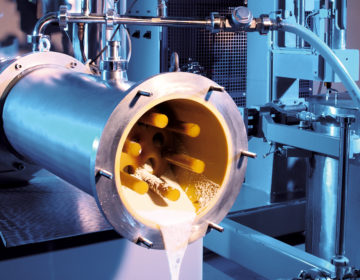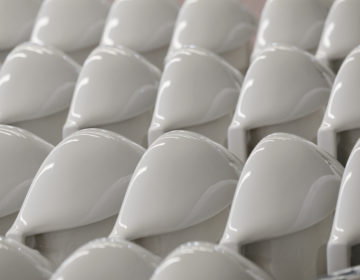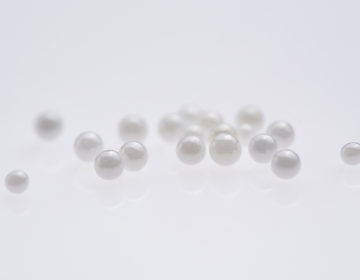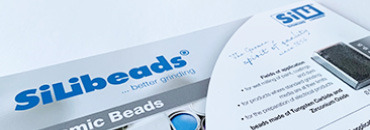What are the advantages of SiLibeads Type ZY 6.0 zirconium oxide beads when grinding in agitator bead mills?
Zirconia beads offer several advantages when grinding in agitator bead mills, making them a popular choice in many industrial and scientific applications:
High hardness and wear resistance: zirconia balls are extremely hard and have excellent wear resistance. This makes them ideal for grinding very hard materials as they are subject to less wear and have a longer life than balls made from softer materials.
High fracture resistance: These balls are characterised by high fracture resistance, which means that they are less susceptible to cracking or breaking under high loads. This is particularly important in high-energy mills, where the balls are constantly subjected to high loads.
Chemical inertness: Zirconia is chemically inert, which means that it does not react with the materials being milled. This is crucial when the purity of the milled product is of great importance, such as in the pharmaceutical industry or in the manufacture of electronic components.
Low contamination: Compared to other grinding balls, zirconium oxide balls result in less contamination of the ground product. This is particularly important in the production of high-purity substances.
High grinding efficiency: Due to their high density, zirconium oxide balls enable more efficient energy transfer during the grinding process. This results in faster and finer grinding of the material compared to lighter balls.
Temperature resistance: Zirconia can withstand high temperatures, making it suitable for applications where high temperatures may occur during the grinding process.
Suitable for high-speed mills: Their high strength and density make zirconia balls suitable for high-speed mills where higher impact and shear forces are applied to the material being ground.
Overall, zirconia balls improve the efficiency and quality of the grinding process in agitator bead mills, especially when processing hard, pure or temperature-sensitive materials. Their properties enable a longer service life, less contamination and efficient energy transfer.
Do SiLibeads Type ZY 6.0 zirconium oxide beads save energy during grinding?
Yes, zirconia beads can help save energy, especially in processes involving the grinding of materials in agitator bead mills. The energy saving effect results from several properties of zirconia beads:
High density and hardness: zirconia balls have a high density and hardness, which allows for more efficient energy transfer to the material being ground. This results in faster and more effective grinding of the material, which in turn consumes less energy compared to softer or lighter grinding balls.
Less wear: Due to their high wear resistance, zirconia balls reduce the need to replace balls frequently, saving energy that would otherwise be spent on replacing and refilling the grinder.
Longer life: The longer life of zirconia balls means that grinders require less maintenance and balls need to be replaced less frequently, helping to reduce overall energy consumption.
Lower maintenance costs: Less wear and tear leads to lower maintenance costs and less downtime for the grinders, which increases the efficiency of the overall operation and reduces energy consumption.
More efficient grinding processes: The high efficiency of zirconia beads in the grinding process can lead to a reduction in the time required for grinding. This can lead to significant energy savings, especially in processes that require a high fineness of the final product.
To summarise, zirconia beads contribute to a reduction in energy consumption due to their physical properties and efficiency in the grinding process. This makes them a cost-effective and energy-efficient option in many industrial grinding applications.
How fine can I grind with 0.1mm or 0.05mm zirconia beads?
The fineness of the grinding result that can be achieved with 0.1 mm or 0.05 mm zirconia beads depends on various factors, but in general, smaller beads allow for finer grinding. Here are some points to consider:
Ball size: Smaller balls, such as 0.05 mm, provide a larger contact area relative to volume and allow for finer grinding of the material. They can grind smaller particles more effectively as they can penetrate into smaller spaces between the particles.
Grinding time: The longer the material is ground, the finer it becomes. However, the longer the grinding time, the higher the energy consumption.
Mill type and operating conditions: The type of mill (e.g. agitator bead mill, planetary bead mill) and its operating conditions (such as speed and filling level) play a significant role in determining the fineness of the end product.
Material properties: The hardness and initial particle size of the material to be ground also influence the result. Harder materials require more energy for fine grinding.
Zirconium oxide ball quality: The quality and uniformity of the zirconium oxide balls also influence the grinding result. High-quality balls with small size deviations and high sphericity lead to better results.
With zirconia balls of 0.1 mm or 0.05 mm, you can usually achieve a very fine particle size, possibly in the micrometre range or even below, depending on the factors mentioned above. For extremely fine applications, such as in pharmaceuticals or in the production of nanomaterials, these small ball sizes are often the preferred choice.
Are tungsten carbide balls such as SiLibeads Type TC 9.5 better or more effective than zirconium oxide balls?
Whether tungsten carbide beads are better than zirconia beads depends largely on the specific application and requirements. Both materials have unique properties that make them suitable for different applications. Here are some points of comparison:
SiLibeads Type TC 9.5 made of tungsten carbide:
Hardness: Tungsten carbide is one of the hardest materials available and offers excellent wear resistance. It is ideal for grinding very hard materials.
Density: Tungsten carbide has a higher density than zirconia, which results in a higher impact force during grinding and makes it more suitable for certain high-energy grinding processes.
Toughness: Whilst tungsten carbide is very hard, under certain conditions it can be less tough than zirconia and more prone to fracture under extreme loads.
Chemical reactivity: Tungsten carbide is less chemically inert than zirconia, which can be a disadvantage in applications where chemical purity is important.
SiLibeads Type ZY 6.0, zirconium oxide beads:
Chemical inertness: Zirconium oxide is chemically inert and does not react with most substances. This makes it ideal for applications where the avoidance of contamination is important.
Fracture resistance: Zirconia has a high fracture resistance, which makes it suitable for applications where the balls are subjected to high loads without breaking.
Versatility: Due to its chemical inertness and good mechanical properties, zirconia is suitable for a wide range of applications, including those in the pharmaceutical and food industries.
Heat resistance: Zirconia is also stable at high temperatures, making it suitable for applications where heat is a factor.
Conclusion
For very hard materials: Tungsten carbide may be more suitable as it is extremely hard and dense.
For applications where chemical purity is important: Zirconium oxide would be preferable as it is chemically more inert.
For applications with high mechanical loads: Zirconia might be preferred due to its higher fracture resistance.
Ultimately, the choice between tungsten carbide and zirconia beads depends on the specific requirements of the grinding application, including factors such as hardness of the grind, chemical purity, desired particle size and grinding process.
When are SiLibeads Type ZY 6.0 zirconia beads used for grinding in the pharmaceutical industry?
Zirconia beads are mainly used in the pharmaceutical industry for grinding and homogenising active pharmaceutical ingredients and other materials, and their specific properties make them particularly advantageous for certain applications. Here are some scenarios in which they are used:
Production of fine powders: In pharmaceuticals, it is often necessary to process active ingredients into very fine powders to ensure effective bioavailability and uniform blends in tablets or capsules. Zirconium oxide beads enable very fine and uniform grinding.
Processing of high purity substances: Due to their chemical inertness, zirconium oxide beads are ideal for processing high-purity substances. They prevent contamination that can occur when using less inert materials.
Nanotechnology applications: In pharmaceutical research and development, particularly in nanotechnology, zirconia beads are used to create nanoparticles for targeted drug delivery and other advanced therapeutic applications.
Avoiding cross-contamination: Their chemical inertness and ease of cleaning make zirconia beads ideal for processes where cross-contamination must be avoided, especially when different products are milled in the same equipment.
Homogenisation of suspensions: In the production of pharmaceutical suspensions, zirconium oxide beads enable effective homogenisation of the ingredients, which is crucial for the consistency and effectiveness of the end product.
Temperature-stable processes: Zirconia can withstand high temperatures, making it suitable for processes where temperature control is important to ensure the stability of active ingredients.
Overall, zirconia beads are used in pharmaceuticals where high purity, precision and efficiency in particle size reduction are required, particularly in the manufacture of medicines where quality and consistency are critical.
Zirconia beads are used in the grinding of LFP for battery production
Zirconium oxide beads are used in the grinding of lithium iron phosphate (LFP), an important cathode material in battery production. Their use in this context is particularly advantageous due to several specific properties:
Chemical inertness: zirconia does not react with lithium iron phosphate or other chemicals used in battery manufacturing. This inertness is crucial to avoid chemical impurities in the final product, which could affect the performance and lifetime of the battery.
High wear resistance: The high hardness and wear resistance of zirconium oxide balls make them ideal for long-lasting grinding of LFP without wearing out quickly. This is important to maintain the consistency and quality of the grinding process and to minimise the replacement of grinding balls, which reduces costs and downtime.
Efficiency in the grinding process: Zirconia balls enable efficient and effective comminution of LFP particles. A fine and uniform particle size is critical to the performance of lithium-ion batteries as it enables a more uniform and efficient electrode structure.
Reducing particle agglomeration: When grinding powders such as LFP, preventing particle agglomeration is important to ensure high reactivity and consistent battery performance. Zirconia beads help to minimise the formation of agglomerates during the grinding process.
Temperature resistance: Zirconia can withstand high temperatures, which is an advantage in processes where heat is generated. This helps to prevent thermal degradation of the materials during the grinding process.
Overall, zirconium oxide beads contribute significantly to the quality and performance of the lithium iron phosphate batteries produced thanks to their chemical inertness, high wear resistance and efficiency in the grinding process. They are a key component in modern battery production, especially in the production of high-performance batteries.
What ball diameters are used for this?
The specific ball diameter used when grinding lithium iron phosphate (LFP) for battery production depends on various factors, such as the desired particle size of the end product, the type of mill and the specific grinding process. In general, however, the following ball diameters are commonly used in the industry:
Small diameters (less than 1 mm): Small zirconia beads, typically in the range of 0.1 mm to 1 mm, are used for fine grinding. They are particularly effective for producing very fine particle sizes and ensure a high surface quality of the milled material.
Medium diameter (1 mm to 3 mm): This size is often used for standard grinding and offers a good compromise between grinding efficiency and fineness of the end product. They are versatile and can be used in a wide range of grinders.
Larger diameters (over 3 mm): Larger balls are typically used for coarse grinding or in applications where a less fine particle size is acceptable. They are effective for the initial reduction of particle size before a fine grinding stage with smaller balls may follow.
The choice of ball diameter is highly dependent on the specific requirements of the grinding process. In the production of LFP for batteries, it is crucial to achieve a uniform and fine particle size, as this can directly affect the performance and lifetime of the battery. In many cases, a combination of different ball sizes is used to achieve the optimum grinding result. It is crucial that the selected ball size works effectively with the mill to achieve the desired particle size, distribution and quality of the LFP powder.
Are you also used to grind silicon for batteries?
The use of zirconia beads to grind silicon for battery applications, particularly for lithium-ion batteries, is feasible and offers several advantages. In battery manufacturing, silicon is increasingly being researched and used as an anode material as it offers a higher energy density than conventional materials such as graphite. Here are some reasons why zirconia beads could be suitable for milling silicon in this context:
Chemical inertness: zirconia does not react with silicon or other materials used in battery anodes, which is important to ensure the purity and performance of the final product.
High hardness and wear resistance: Zirconia beads are very hard and wear resistant, making them suitable for efficient grinding of hard silicon.
Controlled particle size: Precise control of particle size is important for battery applications. Zirconia beads can help achieve a uniform and fine particle size of silicon, which is critical to battery performance and life.
Minimisation of impurities: As no impurities from the beads enter the milled product, the integrity of the silicon is preserved for battery applications.
Energy efficiency: Zirconia beads can enable more efficient energy transfer during the grinding process due to their high density, resulting in a more energy efficient grinding process.
In battery manufacturing, where material quality directly affects battery performance and safety, such considerations are critical. However, the choice of grinding medium also depends on other factors, such as the specific mill design, grinding conditions and cost. Research and development in battery technology, especially for new materials such as silicon anodes, are dynamic areas in which new processes and materials are constantly being evaluated.










